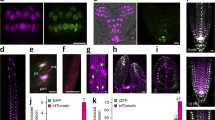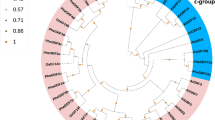Abstract
The plant hormone auxin plays a major role in a variety of growth and developmental responses, even in the more ancient plants—for example, cell differentiation in mosses. Nevertheless, almost nothing is known about the distribution of auxin during moss development. To address this question, we characterised auxin distribution in the moss Physcomitrella patens using auxin-inducible reporter gene systems. Stable transgenic Physcomitrella plants were produced expressing the β-glucuronidase (GUS) gene driven by the auxin-inducible promoters GH3 and DR5, respectively. Both fusions showed remarkable differences with respect to auxin-induced promoter strength and expression kinetics. A detailed characterisation of the GUS expression pattern in different developmental stages revealed that the highest auxin concentrations were in dividing and ontogenetic young cells.






Similar content being viewed by others
Abbreviations
- DR5:
-
Synthetic auxin-inducible promoter
- EST:
-
Expressed sequence tag
- GH3:
-
Promoter of the soybean gh3 gene
- GUS:
-
β-Glucuronidase
- NAA:
-
1-Naphthaleneacetic acid
- 2-NAA:
-
2-Naphthaleneacetic acid
References
Avsian-Kretchmer O, Cheng J-C, Chen L, Moctezuma E, Sung ZR (2002) Indoleacetic acid distribution coincides with vascular differentiation pattern during Arabidopsis leaf ontogeny. Plant Physiol 130:199–209
Bopp M (2000) 50 years of the moss story. In: Progress in botany, vol 61. Springer, Berlin Heidelberg New York, pp 1–34
Bopp M, Atzorn R (1992a) Hormonelle Regulation der Moosentwicklung. Naturwissenschaften 79:337–346
Bopp M, Atzorn R (1992b) The morphogenetic system of the moss protonema. Cryptogam Bot 3:3–10
Cove DJ, Ashton NW (1984) The hormonal regulation of gametophytic development in bryophytes. In: Dyer AF, Duckett JG (eds) The experimental biology of bryophytes. Academic Press, New York, pp 177–201
Egener T, Granado J, Guitton M-C, Hohe A, Holtorf H, Lucht JM, Rensing S, Schlink K, Schulte J, Schween G, Zimmermann S, Duwenig E, Rak B, Reski R (2002) High frequency of phenotypic deviations in Physcomitrella patens plants transformed with a gene-disruption library. BMC Plant Biol 2:6
Friml L, Palme K (2002) Polar auxin transport—old questions and new concepts? Plant Mol Biol 49:273–284
Gorton BS, Eakin RE (1957) Development of the gametophyte in the moss Tortella caespitosa. Bot Gaz 119:31–38
Guilfoyle TJ (1999) Auxin-regulated genes and promoters. In: Hooykaas PPJ, Hall MA, Libbenga KR (eds) Biochemistry and molecular biology of plant hormones. Elsevier, New York, pp 423–459
Hagen G, Guilfoyle TJ (2002) Auxin-responsive gene expression: genes, promoters and regulatory factors. Plant Mol Biol 49:373–385
Hagen G, Kleinschmidt A, Guilfoyle TJ (1984) Auxin-regulated gene expression in intact soybean hypocotyl and excised hypocotyl sections. Planta 162:147–153
Hagen G, Martin G, Li Y, Guilfoyle TJ (1991) Auxin-induced expression of the soybean GH3 promoter in transgenic tobacco plants. Plant Mol Biol 17:567–579
Hohe A, Schween G, Reski R (2001) Establishment of a semicontinous bioreactor culture of Physcomitrella patens for mass production of protoplasts. Acta Hortic 560:425–427
Imaizumi T, Kadota A, Hasebe M, Wada M (2002) Cryptochrome light signals control development to suppress auxin sensitivity in the moss Physcomitrella patens. Plant Cell 14:373–386
Johri MM, Desai S (1973) Auxin regulation of caulonema formation in moss protonema. Nat New Biol 245:223–224
Li Y, Wu YH, Hagen G, Guilfoyle TJ (1999) Expression of the auxin-inducible GH3 promoter/GUS fusion gene as a useful molecular marker for auxin physiology. Plant Cell Physiol 40:675–682
Liu Z, Ulmasov T, Shi X, Hagen G, Guilfoyle TJ (1994) Soybean GH3 promoter contains multiple auxin-inducible elements. Plant Cell 6:645–657
Mathesius U, Schlaman HRM, Spaink HP, Sautter C, Rolfe BG, Djordjevic MA (1998) Auxin transport inhibition precedes root nodule formation in white clover roots and is regulated by flavonoids and derivatives of chitin oligosaccharides. Plant J 14:23–34
Nishiyama T, Hiwatashi Y, Sakakibara K, Kato M, Hasebe M (2000) Tagged mutagenesis and gene-trap in the moss, Physcomitrella patens, by shuttle mutagenesis. DNA Res 7:9-17
Rensing SA, Rombauts S, Van de Peer Y, Reski R (2002) Moss transcriptome and beyond. Trends Plant Sci 7:535–538
Reski R (1998a) Physcomitrella and Arabidopsis: the David and Goliath of reverse genetics. Trends Plant Sci 3:209–210
Reski R (1998b) Development, genetics and molecular biology of mosses. Bot Acta 111:1-15
Reski R, Abel WO (1985) Induction of budding on chloronemata and caulonemata of the moss, Physcomitrella patens, using isopentenyladenine. Planta 165:354–358
Reski R, Faust M, Wang XH, Wehe M, Abel WO (1994) Genome analysis of the moss Physcomitrella patens (Hedw.) B.S.G. Mol Gen Genet 244:352–359
Reutter K, Atzorn R, Hadeler B, Schmülling T, Reski R (1998) Expression of the bacterial ipt gene in Physcomitrella rescues mutations in budding and in plastid division. Planta 206:196–203
Sabatini S, Beis D, Wolkenfelt H, Murfett J, Guilfoyle TJ, Malamy J, Benfey P, Leyser O, Bechtold N, Weisbeek P, Scheres B (1999) An auxin-dependent distal organizer of pattern and polarity in the Arabidopsis root. Cell 99:463–472
Sambrook J, Russell DW (2001) Molecular cloning: a laboratory manual, 3rd edn. Cold Spring Harbor Laboratory Press, Cold Spring Harbor
Strepp R, Scholz S, Kruse S, Speth V, Reski R (1998) Plant nuclear gene knockout reveals a role in plastid division for the homolog of the bacterial cell division protein Ftsz, an ancestral tubulin. Proc Natl Acad Sci USA 95:4368–4373
Theissen G, Münster T, Henschel K (2001) Why don´t mosses flower? New Phytol 150:1-5
Töpfer R, Schell J, Steinbiss H-H (1988) Versatile cloning vectors for transient gene expression and direct gene transfer in plant cells. Nucleic Acids Res 16:8725
Ulmasov T, Liu Z, Hagen G, Guilfoyle TJ (1995) Composite structure of auxin response elements. Plant Cell 7:1611–1623
Ulmasov T, Hagen G, Guilfoyle TJ (1997a) ARF1, a transcription factor that binds to auxin response elements. Science 276:1865–1868
Ulmasov T, Murfett J, Hagen G, Guilfoyle TJ (1997b) Aux/IAA proteins repress expression of reporter genes containing natural and highly active synthetic auxin response elements. Plant Cell 9:1963–1971
Ulmasov T, Hagen G, Guilfoyle TJ (1999) Dimerization and DNA binding of auxin response factors. Plant J 19:309–319
Acknowledgements
This work was supported by the Deutsche Forschungsgemeinschaft via a concerted programme on molecular analysis of phytohormone action (DFG RE 837/6). We thank Tom Guilfoyle and Jane Murfett for kindly providing the GH3::GUS- and the DR5::GUS-containing plasmids and Dr. G. Schween for carrying out the flow cytometric analysis.
Author information
Authors and Affiliations
Corresponding author
Additional information
Communicated by H. Lörz
Rights and permissions
About this article
Cite this article
Bierfreund, N.M., Reski, R. & Decker, E.L. Use of an inducible reporter gene system for the analysis of auxin distribution in the moss Physcomitrella patens . Plant Cell Rep 21, 1143–1152 (2003). https://doi.org/10.1007/s00299-003-0646-1
Received:
Revised:
Accepted:
Published:
Issue Date:
DOI: https://doi.org/10.1007/s00299-003-0646-1




